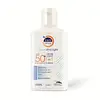What's inside
What's inside
 Key Ingredients
Key Ingredients

 Benefits
Benefits

No benefits
 Concerns
Concerns

No concerns
 Ingredients Side-by-side
Ingredients Side-by-side

Water
Skin ConditioningCyclotetrasiloxane
EmollientTris-Biphenyl Triazine
UV AbsorberCyclopentasiloxane
EmollientBis-PEG-18 Methyl Ether Dimethyl Silane
EmollientIsopentyldiol
HumectantPolymethyl Methacrylate
PEG-12 Dimethicone
Skin ConditioningC12-15 Alkyl Benzoate
AntimicrobialDibutyl Adipate
EmollientCaprylyl Methicone
Skin ConditioningPolymethylsilsesquioxane
Methylene Bis-Benzotriazolyl Tetramethylbutylphenol
UV FilterBis-Ethylhexyloxyphenol Methoxyphenyl Triazine
Skin ConditioningGossypium Hirsutum Extract
Skin ConditioningSodium Stearoyl Glutamate
CleansingDimethicone
EmollientHydroxyacetophenone
Antioxidant1,2-Hexanediol
Skin ConditioningDiisopropyl Adipate
EmollientAmmonium Acryloyldimethyltaurate/Carboxyethyl Acrylate Crosspolymer
Benzylidene Dimethoxydimethylindanone
Skin ProtectingTitanium Dioxide
Cosmetic ColorantPotassium Cetyl Phosphate
EmulsifyingDisodium EDTA
Water, Cyclotetrasiloxane, Tris-Biphenyl Triazine, Cyclopentasiloxane, Bis-PEG-18 Methyl Ether Dimethyl Silane, Isopentyldiol, Polymethyl Methacrylate, PEG-12 Dimethicone, C12-15 Alkyl Benzoate, Dibutyl Adipate, Caprylyl Methicone, Polymethylsilsesquioxane, Methylene Bis-Benzotriazolyl Tetramethylbutylphenol, Bis-Ethylhexyloxyphenol Methoxyphenyl Triazine, Gossypium Hirsutum Extract, Sodium Stearoyl Glutamate, Dimethicone, Hydroxyacetophenone, 1,2-Hexanediol, Diisopropyl Adipate, Ammonium Acryloyldimethyltaurate/Carboxyethyl Acrylate Crosspolymer, Benzylidene Dimethoxydimethylindanone, Titanium Dioxide, Potassium Cetyl Phosphate, Disodium EDTA
 Reviews
Reviews

Ingredients Explained
These ingredients are found in both products.
Ingredients higher up in an ingredient list are typically present in a larger amount.
You might know this ingredient as Tinosorb S or Bemotrizinol. It is a UV filter that covers both UVA and UVB rays.
This ingredient has two peak UV absorption peaks ( 310 and 340 nm) and is able to absorb both UV-A and UV-B rays. This ingredient works by preventing UV rays from reaching and damaging your skin.
On top of that - it is highly photostable and helps prevent the photodegration of other sunscreen ingredients such as avobenzone.
Tinosorb S is allowed in the EU, Australia, and Asia. It is close to being approved by the FDA and we'll hopefully get this ingredient in the U.S. by late 2025.
Fun fact: Tinosorb S is the most effective UV absorber at maximum concentration (measured by SPF) permitted in the EU.
This ingredient is oil-soluble, so your oil-cleansers will take this right off at night.
Learn more about Bis-Ethylhexyloxyphenol Methoxyphenyl TriazineTitanium dioxide is a mineral UV filter widely used in sunscreens and cosmetics.
It is one of only two UV filters officially classified as “mineral” by regulatory agencies, the other being zinc oxide.
Titanium dioxide provides broad-spectrum protection mostly in the UVB and UVAII range, with some protection in the UVAI range.
While its UVA protection isn’t as strong as zinc oxide’s, the difference is minor.
A common myth is that mineral UV filters reflect UV light. However, modern research shows titanium dioxide absorbs UV radiation like chemical filters (~95% absorption & 5% reflection).
Thanks to its non-irritating nature, titanium dioxide is suitable for sensitive, acne-prone, or redness-prone skin. It is unlikely to cause "eye sting" like other sunscreen ingredients.
A major drawback of this ingredient is its white cast and thick texture. This is why mineral sunscreens often leave a white cast and are less cosmetically elegant than chemical/hybrid sunscreens.
To improve white cast and spreadability, micronized or nano-sized titanium dioxide is often used.
There are ongoing concerns surrounding nano-titanium oxide's impact on marine ecosystems.
There is no conclusive evidence that any form of titanium oxide (or any other sunscreen ingredients) will cause harm to marine ecosystems or coral reefs. The science is still developing but many consumers are keeping a close eye on this issue.
Please note, many destinations have reef-safety sunscreen rules. For instance, the U.S. Virgin Islands advises all visitors to use non-nano mineral sunscreens.
Nano mineral sunscreens once raised safety concerns about absorption into skin.
Extensive research has shown that they do not penetrate healthy or damaged skin; they remain safely on the surface and the top layer of dead skin (stratum corneum).
You'll likely find titanium dioxide bundled with alumina, silica, or dimethicone. These ingredients help make titanium dioxide highly photostable; this prevents it from interacting with other formula components under UV light.
Learn more about Titanium Dioxide